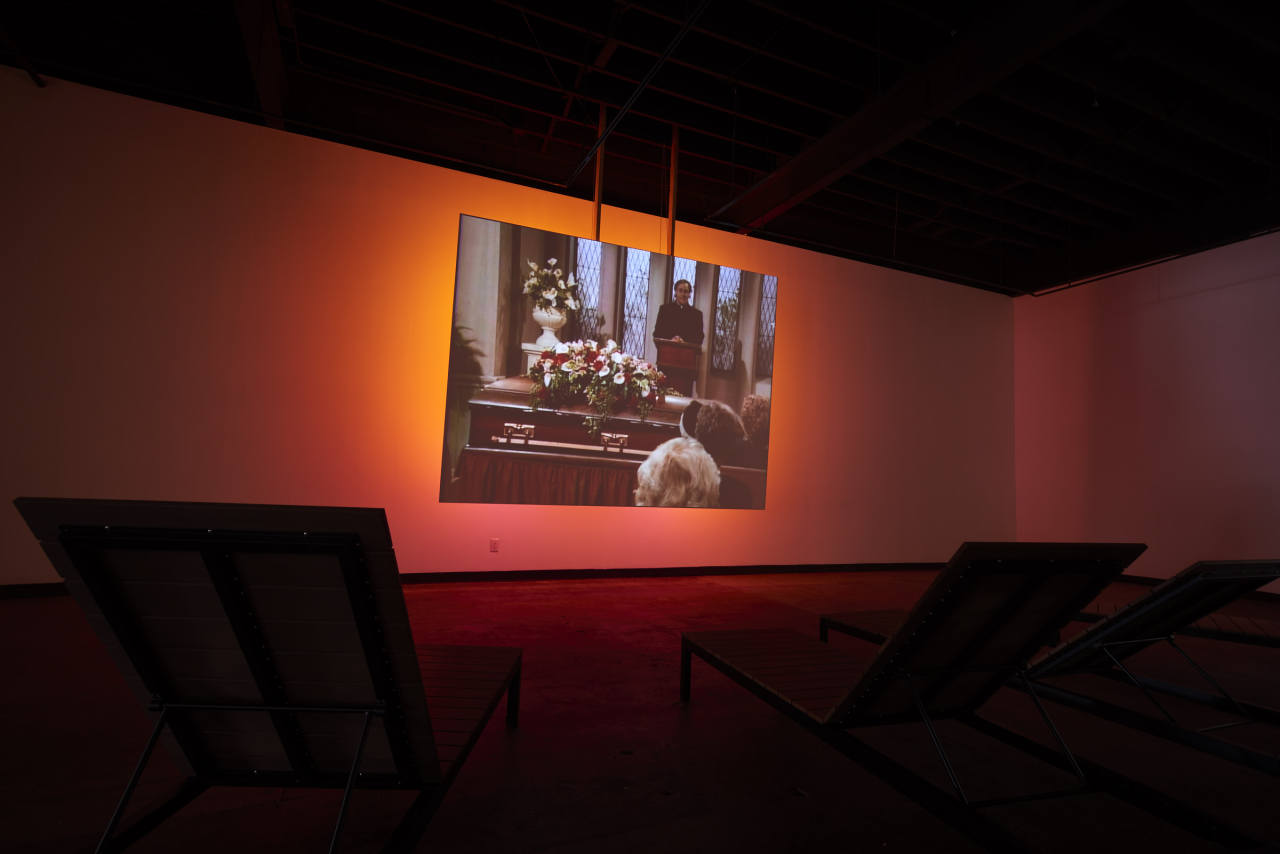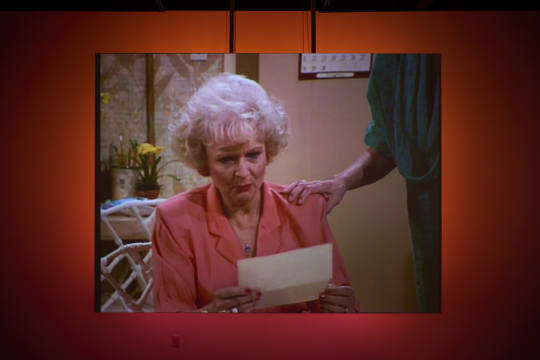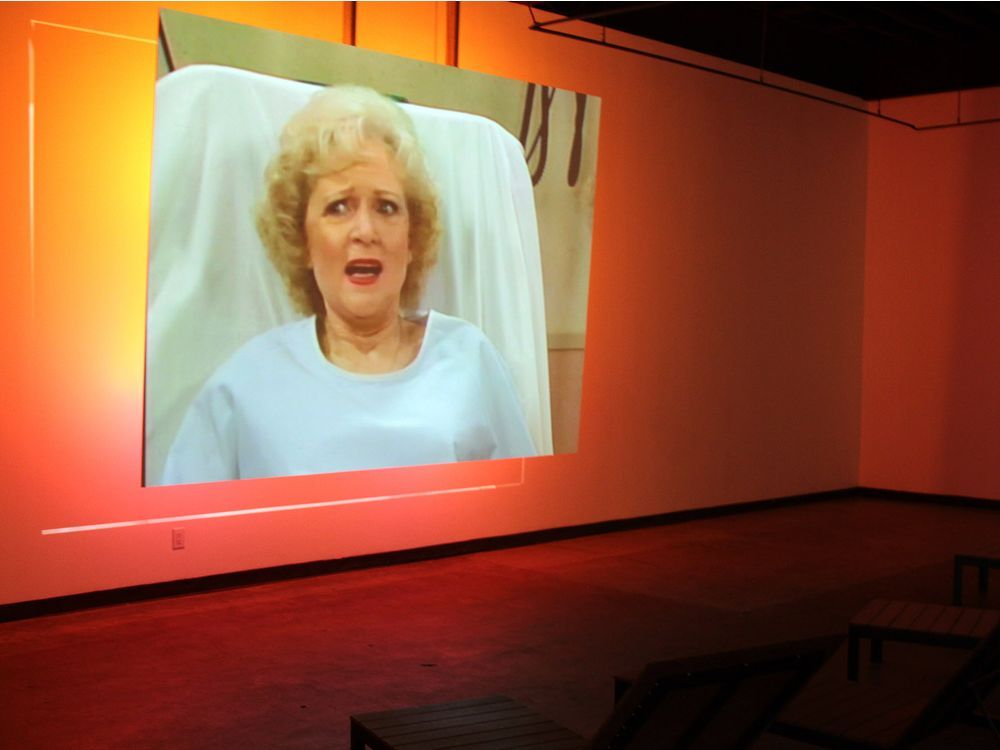Lee Henderson | Palliative Care
August 4–September 10, 2016
Opening reception: Thursday, August 4 at 5 pm
’“Death,” “dies,” “funeral”, “vendetta,” “saint”. In Lee Henderson’s collaged video loop, the characters of TV’s The Golden Girls speak often, and only, of death. This loop is a rediscovery of a cultural touchstone that takes aging as its central subject, experienced from a chaise- langue in a warm, rosy simulation of Floridian summer.
I hope it's death!
by Alison Cooley
As far as I can tell, there is only one mention of death in “Sisters and Other Strangers”—a season five episode of The Golden Girls that originally aired in 1990. When it occurs, Rose has just begun to tell a story about a character named Hans Fleeglefleister from her home city of St. Olaf, and the doorbell rings. Sophia, keeping swift sitcom pace, interjects: “I hope it’s death!”
The episode is not a particular standout in The Golden Girls’ run, and the scene is emphatically nothing special, either. But it underscores one of The Golden Girls’ central revolutionary functions: it was a show about women over 50 who knew what was what and spoke their minds. Its reputation as a cultural boundary-breaker persists, largely thanks to its unapologetic examination of aging, sex, LGBTQ issues, and—naturally—death. Death in the broad, theoretical, lurking sense (of the capacity for expiration inside each of us), but also in the specific, jarring, wretched sense (of the people we love being gone from us in every possible, irretrievable way).
Lee Henderson’s “Palliative Care (1985-1992)” compiles every mention of death and dying across The Golden Girls’ seven seasons, as well as plenty of parallel terms: mourning, grieving, funeral, suicide, choking, murder, heart-attack, wake, buried, will, stabbed, killed, electrocuted, shot, beheaded, heaven. Henderson’s morbid supercut keeps pace with the girls’ witty repartee and no-nonsense manner, the logic of his editing preserving the pauses and the canned laughter that accompanies death’s mentions. Spryly, the accumulation maneuvers onwards to the next clip the moment another word might infringe on death’s space.
“Palliative Care” is a Golden Girls shrine, or it’s a cocoon, or its an enclosure, a restraint. But it’s also a cultural commentary, at other times a re-attunement of a collective sensitivity to death. Henderson’s chronological arrangement of clips surfaces small harmonies. Units of speech become a deluge. Whatever story normally anchors each word gets washed in repetition until the video conjures some new sensation. It’s easy to find oneself imaging—as I find myself imaging—the worlds that originate these milliseconds-long excerpts, to assume some piece of context that can’t be read in the Miami pastels, the leafy curtains, the country kitchen, the way they carry themselves with their falsely-broad shoulders, the wringing of hands, the appearance of some stranger who doesn’t belong to the usual four. I guess which “deaths” are punchlines and which are breakdowns, until they are all punchlines, until they are all breakdowns. The sense of the words gets lost and then pulled back again in a pause like a gasp for air, a kick in the gut.
“Palliative Care” is seductive, familiar, it glows. An obsessive quoter of popular culture and art history, Henderson describes the space of his video installation as akin to the room in Soylent Green where Sol Roth is euthanized to a soothing program of nature videos and “light” classical music. The gallery, he argues, is not so different from this otherworldly space: “a secular space in which to rehearse our rituals for oblivion.” Henderson’s installation beckons us closer just as it warns us to stay away. The Golden Girls are welcome and warm, we recognize ourselves in them. Perhaps we are put off to see ourselves treating death so casually (perhaps we are relieved). I’m reminded of how nonchalantly we use death as a metaphor, a turn of phrase, a functional unit of colloquiality (to kill two birds with one stone, to be bored to death, to be dead- on, killing it, die laughing).
When these fragments surge together, across seven successions, they can’t help but surface a tension: death’s casual presence in our lives and our language; alongside its always-exceptionalness, its each-time-specific trauma. Damned if I wouldn’t prefer to be surrounded by The Golden Girls next time I have to think hard and deep about death.
-
Alison Cooley is a critic, curator and educator based in Toronto. Her research deals with the intersection of natural history and visual culture, socially engaged artistic practice, and experiential and interpretative dimensions of art criticism. She is the 2014 recipient of the Middlebrook Prize for Young Canadian Curators, and her work has been published in Canadian Art, KAPSULA, FUSE, Blackflash and Magenta, among others.




